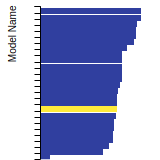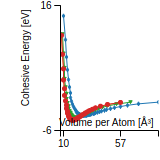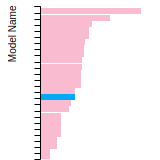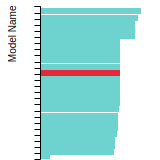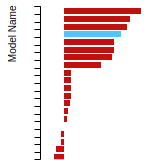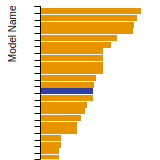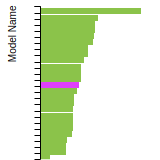 EAM_Dynamo_Olsson_2010_Au__MO_228280943430_000
EAM_Dynamo_Olsson_2010_Au__MO_228280943430_000
| Title
A single sentence description.
|
EAM potential (LAMMPS cubic hermite tabulation) for Au developed by Olsson (2010) v000 |
|---|---|
| Description
A short description of the Model describing its key features including for example: type of model (pair potential, 3-body potential, EAM, etc.), modeled species (Ac, Ag, ..., Zr), intended purpose, origin, and so on.
|
LAMMPS compatible EAM/alloy potential for Au. Used in a series of nanowire modeling projects. |
| Species
The supported atomic species.
| Au |
| Disclaimer
A statement of applicability provided by the contributor, informing users of the intended use of this KIM Item.
|
None |
| Content Origin | NIST IPRP https://www.ctcms.nist.gov/potentials/Au.html |
| Contributor |
Ronald E. Miller |
| Maintainer |
Ronald E. Miller |
| Developer | Pär A. T. Olsson |
| Published on KIM | 2018 |
| How to Cite |
This Model originally published in [1] is archived in OpenKIM [2-5]. [1] Olsson PAT. Transverse resonant properties of strained gold nanowires. J Appl Phys. 2010Aug;108(3). doi:10.1063/1.3460127 — (Primary Source) A primary source is a reference directly related to the item documenting its development, as opposed to other sources that are provided as background information. [2] Olsson PAT. EAM potential (LAMMPS cubic hermite tabulation) for Au developed by Olsson (2010) v000. OpenKIM; 2018. doi:10.25950/fe43ad59 [3] Foiles SM, Baskes MI, Daw MS, Plimpton SJ. EAM Model Driver for tabulated potentials with cubic Hermite spline interpolation as used in LAMMPS v005. OpenKIM; 2018. doi:10.25950/68defa36 [4] Tadmor EB, Elliott RS, Sethna JP, Miller RE, Becker CA. The potential of atomistic simulations and the Knowledgebase of Interatomic Models. JOM. 2011;63(7):17. doi:10.1007/s11837-011-0102-6 [5] Elliott RS, Tadmor EB. Knowledgebase of Interatomic Models (KIM) Application Programming Interface (API). OpenKIM; 2011. doi:10.25950/ff8f563a Click here to download the above citation in BibTeX format. |
| Citations
This panel presents information regarding the papers that have cited the interatomic potential (IP) whose page you are on. The OpenKIM machine learning based Deep Citation framework is used to determine whether the citing article actually used the IP in computations (denoted by "USED") or only provides it as a background citation (denoted by "NOT USED"). For more details on Deep Citation and how to work with this panel, click the documentation link at the top of the panel. The word cloud to the right is generated from the abstracts of IP principle source(s) (given below in "How to Cite") and the citing articles that were determined to have used the IP in order to provide users with a quick sense of the types of physical phenomena to which this IP is applied. The bar chart shows the number of articles that cited the IP per year. Each bar is divided into green (articles that USED the IP) and blue (articles that did NOT USE the IP). Users are encouraged to correct Deep Citation errors in determination by clicking the speech icon next to a citing article and providing updated information. This will be integrated into the next Deep Citation learning cycle, which occurs on a regular basis. OpenKIM acknowledges the support of the Allen Institute for AI through the Semantic Scholar project for providing citation information and full text of articles when available, which are used to train the Deep Citation ML algorithm. |
This panel provides information on past usage of this interatomic potential (IP) powered by the OpenKIM Deep Citation framework. The word cloud indicates typical applications of the potential. The bar chart shows citations per year of this IP (bars are divided into articles that used the IP (green) and those that did not (blue)). The complete list of articles that cited this IP is provided below along with the Deep Citation determination on usage. See the Deep Citation documentation for more information. 
41 Citations (32 used)
Help us to determine which of the papers that cite this potential actually used it to perform calculations. If you know, click the .
USED (definite) S. M. Rassoulinejad-Mousavi and Y. Zhang, “Interatomic Potentials Transferability for Molecular Simulations: A Comparative Study for Platinum, Gold and Silver,” Scientific Reports. 2018. link Times cited: 33 USED (high confidence) E. Yildirim et al., “Simple Synthesis of Monodisperse Ultrasmall Au Icosahedral Nanoparticles,” The Journal of Physical Chemistry C. 2023. link Times cited: 2 USED (high confidence) E. Pervolarakis, G. Tritsaris, P. Rosakis, and I. Remediakis, “Machine Learning for the edge energies of high symmetry Au nanoparticles,” Surface Science. 2022. link Times cited: 1 USED (high confidence) Y. Geng et al., “Dissociation of Tilt Dislocation Walls in Au,” Acta Metallurgica Sinica (English Letters). 2022. link Times cited: 0 USED (high confidence) F. Saleem et al., “Size-Dependent Phase Transformation of Noble Metal Nanomaterials.,” Small. 2019. link Times cited: 15 Abstract: As an important aspect of crystal phase engineering, control… read more USED (high confidence) H. Xie, J. Yu, T. Yu, and F. Yin, “Face-centred cubic to body-centred cubic phase transformation under [1 0 0] tensile loading,” Philosophical Magazine. 2018. link Times cited: 2 Abstract: ABSTRACT Molecular dynamics simulation was used to verify a … read more USED (high confidence) P. Olsson, H. S. Park, and P. Lidström, “The Influence of shearing and rotary inertia on the resonant properties of gold nanowires,” Journal of Applied Physics. 2010. link Times cited: 25 Abstract: In a previous publication [ P. A. T. Olsson, J. Appl. Phys. … read more USED (low confidence) L. Morrissey, “Hydrogen embrittlement of iron nanowires: investigating size and orientation dependence on loading behaviour,” Molecular Simulation. 2023. link Times cited: 0 USED (low confidence) P. Olsson et al., “Grain Size-Dependent Thermal Expansion of Nanocrystalline Metals,” Materials. 2023. link Times cited: 0 Abstract: In the present work, we have used classical molecular dynami… read more USED (low confidence) S. Xu, X. Fan, C. Gu, W. Zheng, and D. J. Singh, “Molecular Dynamics Study of the Tensile Properties of Gold Nanocrystalline Films Irradiated by Gallium Ions,” Journal of Nuclear Materials. 2023. link Times cited: 0 USED (low confidence) X. Gao, N. Li, Z. Song, K. Wu, Y. Cheng, and B.-yang Xiao, “Atomic structure evolution and linear regression fitting models for pre-breakdown electric field strength of FCC, BCC and HCP metal nano-emitters under high electric field from PIC-ED–MD simulations,” Journal of Physics D: Applied Physics. 2023. link Times cited: 1 Abstract: Multi-scale and multi-physics simulations are carried out fo… read more USED (low confidence) V. Kushch, “Atomistic and continuum modeling of nanoparticles: Elastic fields, surface constants, and effective stiffness,” International Journal of Engineering Science. 2023. link Times cited: 0 USED (low confidence) F. Valencia et al., “Probing the Mechanical Properties of Porous Nanoshells by Nanoindentation,” Nanomaterials. 2022. link Times cited: 2 Abstract: In this contribution, we present a study of the mechanical p… read more USED (low confidence) A. Mahata and M. Kivy, “Computational study of nanoscale mechanical properties of Fe–Cr–Ni alloy,” Molecular Simulation. 2022. link Times cited: 1 Abstract: ABSTRACT Mechanical properties of Fe–Cr–Ni alloy nanowires h… read more USED (low confidence) T. Zolotoukhina, M. Yamada, and S. Iwakura, “Vibrational Spectra of Nucleotides in the Presence of the Au Cluster Enhancer in MD Simulation of a SERS Sensor †,” Biosensors. 2021. link Times cited: 3 Abstract: Surface-enhanced Raman scattering (SERS) nanoprobes have sho… read more USED (low confidence) T. Zolotoukhina, M. Yamada, and S. Iwakura, “Influence of the Au cluster enhancer on vibrational spectra of nucleotides in MD simulation of a SERS sensor,” Proceedings of The 1st International Electronic Conference on Biosensors. 2020. link Times cited: 2 Abstract: Surface-enhanced Raman scattering (SERS) nanoprobes have sho… read more USED (low confidence) S. Starikov, I. Gordeev, Y. Lysogorskiy, L. Kolotova, and S. Makarov, “Optimized interatomic potential for study of structure and phase transitions in Si-Au and Si-Al systems,” Computational Materials Science. 2020. link Times cited: 19 USED (low confidence) H. L. Mai, X. Cui, and S. Ringer, “Mechanical properties of ultrathin gold nanowires from first principles: Interdependencies between size, morphology, and twin boundaries,” Physical Review Materials. 2020. link Times cited: 3 Abstract: The mechanical behavior of $\ensuremath{\langle}111\ensurema… read more USED (low confidence) M. Porterfield and D. Borca-Tasciuc, “Molecular Dynamics Simulation of Ultra-Fast Phase Transition in Water Nanofilms,” Journal of Heat Transfer. 2020. link Times cited: 1 Abstract:
Molecular dynamics simulations are used to explore explosi… read more USED (low confidence) S. Surulere, M. Shatalov, A. C. Mkolesia, and A. Adeniji, “A Comparative Investigation of Complex Conjugate Eigenvalues of Generalized Morse and Classical Lennard-Jones Potential for Metal Atoms.” 2020. link Times cited: 0 Abstract:
The knowledge of parameter estimation for interatomic pote… read more USED (low confidence) U. Kurelchuk, P. V. Borisyuk, and O. Vasilyev, “Electron properties of 13-atom nanoparticle superlattices,” Materials Letters. 2020. link Times cited: 0 USED (low confidence) B. Bertin, J. Durinck, and J. Colin, “Dislocation emission and crack propagation during thin film buckling on substrate,” International Journal of Solids and Structures. 2020. link Times cited: 3 USED (low confidence) A. Thorn, J. Rojas-Nunez, S. Hajinazar, S. Baltazar, and A. Kolmogorov, “Toward ab Initio Ground States of Gold Clusters via Neural Network Modeling,” The Journal of Physical Chemistry C. 2019. link Times cited: 17 Abstract: Prescreening candidate structures with reliable classical po… read more USED (low confidence) S. Yin, G. Cheng, G. Richter, H. Gao, and Y. Zhu, “Transition of Deformation Mechanisms in Single Crystalline Metallic Nanowires.,” ACS nano. 2019. link Times cited: 31 Abstract: Twinning and dislocation slip are two competitive deformatio… read more USED (low confidence) H. N. Pishkenari, F. S. Yousefi, and A. Taghibakhshi, “Determination of surface properties and elastic constants of FCC metals: a comparison among different EAM potentials in thin film and bulk scale,” Materials Research Express. 2018. link Times cited: 22 Abstract: Three independent elastic constants C11, C12, and C44 were c… read more USED (low confidence) J. Wu, X. F. Li, A.-Y. Tang, and K. Lee, “Free and forced transverse vibration of nanowires with surface effects,” Journal of Vibration and Control. 2017. link Times cited: 33 Abstract: This paper presents a theoretical analysis of free vibration… read more USED (low confidence) B. Xing, S. Yan, W. Jiang, and Q. Qin, “Atomistic Study for the Vibrational Properties on Σ5 Symmetric Tilt Bicrystal Copper Nanowires,” Applied Mechanics and Materials. 2016. link Times cited: 2 Abstract: In this study, an atomistic simulation was performed to inve… read more USED (low confidence) H. N. Pishkenari, B. Afsharmanesh, and F. Tajaddodianfar, “Continuum models calibrated with atomistic simulations for the transverse vibrations of silicon nanowires,” International Journal of Engineering Science. 2016. link Times cited: 27 USED (low confidence) K. Kunal and N. Aluru, “Intrinsic dissipation in a nano-mechanical resonator,” Journal of Applied Physics. 2014. link Times cited: 16 Abstract: We investigate the effect of size on intrinsic dissipation i… read more USED (low confidence) Y. Zheng, Y. Zhao, H. F. Ye, and H. W. Zhang, “Size-dependent elastic moduli and vibrational properties of fivefold twinned copper nanowires,” Nanotechnology. 2014. link Times cited: 20 Abstract: Based on atomistic simulations, the elastic moduli and vibra… read more USED (low confidence) L. Morrissey, S. M. Handrigan, and S. Nakhla, “Discrepancies in the mechanical properties of gold nanowires: The importance of potential type and equilibration method,” Computational Materials Science. 2020. link Times cited: 6 USED (low confidence) J. Zhang and S. Meguid, “Piezoelectric Response at Nanoscale.” 2016. link Times cited: 1 NOT USED (low confidence) S. Surulere, M. Shatalov, A. C. Mkolesia, and I. Fedotov, “A Modern Approach for the Identification of the Classical and Modified Generalized Morse Potential.” 2020. link Times cited: 5 Abstract:
This paper proposes an approach for parameter estimation o… read more NOT USED (high confidence) S. Surulere, M. Shatalov, and E. Olayiwola, “Optimal interatomic potentials using modified method of least squares: Optimal form of interatomic potentials,” Open Physics. 2023. link Times cited: 0 Abstract: The problem of optimization of interatomic potentials is for… read more NOT USED (high confidence) S. Surulere, M. Shatalov, A. C. Mkolesia, and J. Ehigie, “A Novel Identification of the Extended-Rydberg Potential Energy Function,” Computational Mathematics and Mathematical Physics. 2019. link Times cited: 2 NOT USED (high confidence) Z. Zheng, E. Li, N. Ding, and X. Xu, “A Molecular Dynamic Study on Nonlinear Vibration Behaviors of Fe Nanowires,” International Journal of Computational Methods. 2017. link Times cited: 1 Abstract: In this paper, vibration behaviors of Fe nanowires are inves… read more NOT USED (high confidence) X.-jian Xu, Z. Deng, and B. Wang, “Closed solutions for the electromechanical bending and vibration of thick piezoelectric nanobeams with surface effects,” Journal of Physics D: Applied Physics. 2013. link Times cited: 15 Abstract: In this paper, a more accurate model is established to study… read more NOT USED (high confidence) P. Olsson and H. S. Park, “On the importance of surface elastic contributions to the flexural rigidity of nanowires,” Journal of The Mechanics and Physics of Solids. 2012. link Times cited: 57 NOT USED (high confidence) Q. He and C. Lilley, “Resonant frequency analysis of Timoshenko nanowires with surface stress for different boundary conditions,” Journal of Applied Physics. 2012. link Times cited: 26 Abstract: The influence of both surface and shear effects on the reson… read more NOT USED (high confidence) H. Zhan and Y. T. Gu, “A fundamental numerical and theoretical study for the vibrational properties of nanowires,” Journal of Applied Physics. 2012. link Times cited: 36 Abstract: Based on the molecular dynamics (MD) simulation and the clas… read more NOT USED (high confidence) P. Olsson and H. S. Park, “Atomistic study of the buckling of gold nanowires,” Acta Materialia. 2011. link Times cited: 30 |
| Funding | Not available |
| Short KIM ID
The unique KIM identifier code.
| MO_228280943430_000 |
| Extended KIM ID
The long form of the KIM ID including a human readable prefix (100 characters max), two underscores, and the Short KIM ID. Extended KIM IDs can only contain alpha-numeric characters (letters and digits) and underscores and must begin with a letter.
| EAM_Dynamo_Olsson_2010_Au__MO_228280943430_000 |
| DOI |
10.25950/fe43ad59 https://doi.org/10.25950/fe43ad59 https://commons.datacite.org/doi.org/10.25950/fe43ad59 |
| KIM Item Type
Specifies whether this is a Portable Model (software implementation of an interatomic model); Portable Model with parameter file (parameter file to be read in by a Model Driver); Model Driver (software implementation of an interatomic model that reads in parameters).
| Portable Model using Model Driver EAM_Dynamo__MD_120291908751_005 |
| Driver | EAM_Dynamo__MD_120291908751_005 |
| KIM API Version | 2.0 |
| Potential Type | eam |
| Grade | Name | Category | Brief Description | Full Results | Aux File(s) |
|---|---|---|---|---|---|
| P | vc-species-supported-as-stated | mandatory | The model supports all species it claims to support; see full description. |
Results | Files |
| P | vc-periodicity-support | mandatory | Periodic boundary conditions are handled correctly; see full description. |
Results | Files |
| P | vc-permutation-symmetry | mandatory | Total energy and forces are unchanged when swapping atoms of the same species; see full description. |
Results | Files |
| A | vc-forces-numerical-derivative | consistency | Forces computed by the model agree with numerical derivatives of the energy; see full description. |
Results | Files |
| P | vc-dimer-continuity-c1 | informational | The energy versus separation relation of a pair of atoms is C1 continuous (i.e. the function and its first derivative are continuous); see full description. |
Results | Files |
| P | vc-objectivity | informational | Total energy is unchanged and forces transform correctly under rigid-body translation and rotation; see full description. |
Results | Files |
| P | vc-inversion-symmetry | informational | Total energy is unchanged and forces change sign when inverting a configuration through the origin; see full description. |
Results | Files |
| P | vc-memory-leak | informational | The model code does not have memory leaks (i.e. it releases all allocated memory at the end); see full description. |
Results | Files |
| P | vc-thread-safe | mandatory | The model returns the same energy and forces when computed in serial and when using parallel threads for a set of configurations. Note that this is not a guarantee of thread safety; see full description. |
Results | Files |
| P | vc-unit-conversion | mandatory | The model is able to correctly convert its energy and/or forces to different unit sets; see full description. |
Results | Files |
BCC Lattice Constant
This bar chart plot shows the mono-atomic body-centered cubic (bcc) lattice constant predicted by the current model (shown in the unique color) compared with the predictions for all other models in the OpenKIM Repository that support the species. The vertical bars show the average and standard deviation (one sigma) bounds for all model predictions. Graphs are generated for each species supported by the model.
Cohesive Energy Graph
This graph shows the cohesive energy versus volume-per-atom for the current mode for four mono-atomic cubic phases (body-centered cubic (bcc), face-centered cubic (fcc), simple cubic (sc), and diamond). The curve with the lowest minimum is the ground state of the crystal if stable. (The crystal structure is enforced in these calculations, so the phase may not be stable.) Graphs are generated for each species supported by the model.
Diamond Lattice Constant
This bar chart plot shows the mono-atomic face-centered diamond lattice constant predicted by the current model (shown in the unique color) compared with the predictions for all other models in the OpenKIM Repository that support the species. The vertical bars show the average and standard deviation (one sigma) bounds for all model predictions. Graphs are generated for each species supported by the model.
Dislocation Core Energies
This graph shows the dislocation core energy of a cubic crystal at zero temperature and pressure for a specific set of dislocation core cutoff radii. After obtaining the total energy of the system from conjugate gradient minimizations, non-singular, isotropic and anisotropic elasticity are applied to obtain the dislocation core energy for each of these supercells with different dipole distances. Graphs are generated for each species supported by the model.
(No matching species)FCC Elastic Constants
This bar chart plot shows the mono-atomic face-centered cubic (fcc) elastic constants predicted by the current model (shown in blue) compared with the predictions for all other models in the OpenKIM Repository that support the species. The vertical bars show the average and standard deviation (one sigma) bounds for all model predictions. Graphs are generated for each species supported by the model.
FCC Lattice Constant
This bar chart plot shows the mono-atomic face-centered cubic (fcc) lattice constant predicted by the current model (shown in red) compared with the predictions for all other models in the OpenKIM Repository that support the species. The vertical bars show the average and standard deviation (one sigma) bounds for all model predictions. Graphs are generated for each species supported by the model.
FCC Stacking Fault Energies
This bar chart plot shows the intrinsic and extrinsic stacking fault energies as well as the unstable stacking and unstable twinning energies for face-centered cubic (fcc) predicted by the current model (shown in blue) compared with the predictions for all other models in the OpenKIM Repository that support the species. The vertical bars show the average and standard deviation (one sigma) bounds for all model predictions. Graphs are generated for each species supported by the model.
FCC Surface Energies
This bar chart plot shows the mono-atomic face-centered cubic (fcc) relaxed surface energies predicted by the current model (shown in blue) compared with the predictions for all other models in the OpenKIM Repository that support the species. The vertical bars show the average and standard deviation (one sigma) bounds for all model predictions. Graphs are generated for each species supported by the model.
SC Lattice Constant
This bar chart plot shows the mono-atomic simple cubic (sc) lattice constant predicted by the current model (shown in the unique color) compared with the predictions for all other models in the OpenKIM Repository that support the species. The vertical bars show the average and standard deviation (one sigma) bounds for all model predictions. Graphs are generated for each species supported by the model.
Cubic Crystal Basic Properties Table
Species: AuCreators:
Contributor: karls
Publication Year: 2019
DOI: https://doi.org/10.25950/64cb38c5
This Test Driver uses LAMMPS to compute the cohesive energy of a given monoatomic cubic lattice (fcc, bcc, sc, or diamond) at a variety of lattice spacings. The lattice spacings range from a_min (=a_min_frac*a_0) to a_max (=a_max_frac*a_0) where a_0, a_min_frac, and a_max_frac are read from stdin (a_0 is typically approximately equal to the equilibrium lattice constant). The precise scaling and number of lattice spacings sampled between a_min and a_0 (a_0 and a_max) is specified by two additional parameters passed from stdin: N_lower and samplespacing_lower (N_upper and samplespacing_upper). Please see README.txt for further details.
| Test | Test Results | Link to Test Results page | Benchmark time
Usertime multiplied by the Whetstone Benchmark. This number can be used (approximately) to compare the performance of different models independently of the architecture on which the test was run.
Measured in Millions of Whetstone Instructions (MWI) |
|---|---|---|---|
| Cohesive energy versus lattice constant curve for bcc Au v004 | view | 7589 | |
| Cohesive energy versus lattice constant curve for diamond Au v004 | view | 7917 | |
| Cohesive energy versus lattice constant curve for fcc Au v004 | view | 7231 | |
| Cohesive energy versus lattice constant curve for sc Au v004 | view | 8687 |
Creators: Junhao Li and Ellad Tadmor
Contributor: tadmor
Publication Year: 2019
DOI: https://doi.org/10.25950/5853fb8f
Computes the cubic elastic constants for some common crystal types (fcc, bcc, sc, diamond) by calculating the hessian of the energy density with respect to strain. An estimate of the error associated with the numerical differentiation performed is reported.
| Test | Test Results | Link to Test Results page | Benchmark time
Usertime multiplied by the Whetstone Benchmark. This number can be used (approximately) to compare the performance of different models independently of the architecture on which the test was run.
Measured in Millions of Whetstone Instructions (MWI) |
|---|---|---|---|
| Elastic constants for bcc Au at zero temperature v006 | view | 2335 | |
| Elastic constants for diamond Au at zero temperature v001 | view | 3487 | |
| Elastic constants for fcc Au at zero temperature v006 | view | 1663 | |
| Elastic constants for sc Au at zero temperature v006 | view | 1791 |
Creators: Junhao Li
Contributor: jl2922
Publication Year: 2019
DOI: https://doi.org/10.25950/d794c746
Computes the elastic constants for hcp crystals by calculating the hessian of the energy density with respect to strain. An estimate of the error associated with the numerical differentiation performed is reported.
| Test | Test Results | Link to Test Results page | Benchmark time
Usertime multiplied by the Whetstone Benchmark. This number can be used (approximately) to compare the performance of different models independently of the architecture on which the test was run.
Measured in Millions of Whetstone Instructions (MWI) |
|---|---|---|---|
| Elastic constants for hcp Au at zero temperature v004 | view | 1815 |
Creators:
Contributor: ilia
Publication Year: 2023
DOI: https://doi.org/10.25950/e8a7ed84
Computes the equilibrium crystal structure and energy for an arbitrary crystal at zero temperature and applied stress by performing symmetry-constrained relaxation. The crystal structure is specified using the AFLOW prototype designation. Multiple sets of free parameters corresponding to the crystal prototype may be specified as initial guesses for structure optimization. No guarantee is made regarding the stability of computed equilibria, nor that any are the ground state.
| Test | Test Results | Link to Test Results page | Benchmark time
Usertime multiplied by the Whetstone Benchmark. This number can be used (approximately) to compare the performance of different models independently of the architecture on which the test was run.
Measured in Millions of Whetstone Instructions (MWI) |
|---|---|---|---|
| Equilibrium crystal structure and energy for Au in AFLOW crystal prototype A_cF4_225_a v001 | view | 73032 |
Creators: Daniel S. Karls and Junhao Li
Contributor: karls
Publication Year: 2019
DOI: https://doi.org/10.25950/2765e3bf
Equilibrium lattice constant and cohesive energy of a cubic lattice at zero temperature and pressure.
| Test | Test Results | Link to Test Results page | Benchmark time
Usertime multiplied by the Whetstone Benchmark. This number can be used (approximately) to compare the performance of different models independently of the architecture on which the test was run.
Measured in Millions of Whetstone Instructions (MWI) |
|---|---|---|---|
| Equilibrium zero-temperature lattice constant for bcc Au v007 | view | 1919 | |
| Equilibrium zero-temperature lattice constant for diamond Au v007 | view | 2687 | |
| Equilibrium zero-temperature lattice constant for fcc Au v007 | view | 3487 | |
| Equilibrium zero-temperature lattice constant for sc Au v007 | view | 2207 |
Creators: Daniel S. Karls and Junhao Li
Contributor: karls
Publication Year: 2019
DOI: https://doi.org/10.25950/c339ca32
Calculates lattice constant of hexagonal bulk structures at zero temperature and pressure by using simplex minimization to minimize the potential energy.
| Test | Test Results | Link to Test Results page | Benchmark time
Usertime multiplied by the Whetstone Benchmark. This number can be used (approximately) to compare the performance of different models independently of the architecture on which the test was run.
Measured in Millions of Whetstone Instructions (MWI) |
|---|---|---|---|
| Equilibrium lattice constants for hcp Au v005 | view | 17573 |
Creators: Mingjian Wen
Contributor: mjwen
Publication Year: 2019
DOI: https://doi.org/10.25950/fc69d82d
This Test Driver uses LAMMPS to compute the linear thermal expansion coefficient at a finite temperature under a given pressure for a cubic lattice (fcc, bcc, sc, diamond) of a single given species.
| Test | Test Results | Link to Test Results page | Benchmark time
Usertime multiplied by the Whetstone Benchmark. This number can be used (approximately) to compare the performance of different models independently of the architecture on which the test was run.
Measured in Millions of Whetstone Instructions (MWI) |
|---|---|---|---|
| Linear thermal expansion coefficient of fcc Au at 293.15 K under a pressure of 0 MPa v001 | view | 8706030 |
Creators: Matt Bierbaum
Contributor: mattbierbaum
Publication Year: 2019
DOI: https://doi.org/10.25950/64f4999b
Calculates the phonon dispersion relations for fcc lattices and records the results as curves.
| Test | Test Results | Link to Test Results page | Benchmark time
Usertime multiplied by the Whetstone Benchmark. This number can be used (approximately) to compare the performance of different models independently of the architecture on which the test was run.
Measured in Millions of Whetstone Instructions (MWI) |
|---|---|---|---|
| Phonon dispersion relations for fcc Au v004 | view | 51694 |
Creators:
Contributor: SubrahmanyamPattamatta
Publication Year: 2019
DOI: https://doi.org/10.25950/b4cfaf9a
Intrinsic and extrinsic stacking fault energies, unstable stacking fault energy, unstable twinning energy, stacking fault energy as a function of fractional displacement, and gamma surface for a monoatomic FCC lattice at zero temperature and pressure.
| Test | Test Results | Link to Test Results page | Benchmark time
Usertime multiplied by the Whetstone Benchmark. This number can be used (approximately) to compare the performance of different models independently of the architecture on which the test was run.
Measured in Millions of Whetstone Instructions (MWI) |
|---|---|---|---|
| Stacking and twinning fault energies for fcc Au v002 | view | 6088754 |
Creators: Matt Bierbaum
Contributor: mattbierbaum
Publication Year: 2019
DOI: https://doi.org/10.25950/6c43a4e6
Calculates the surface energy of several high symmetry surfaces and produces a broken-bond model fit. In latex form, the fit equations are given by:
E_{FCC} (\vec{n}) = p_1 (4 \left( |x+y| + |x-y| + |x+z| + |x-z| + |z+y| +|z-y|\right)) + p_2 (8 \left( |x| + |y| + |z|\right)) + p_3 (2 ( |x+ 2y + z| + |x+2y-z| + |x-2y + z| + |x-2y-z| + |2x+y+z| + |2x+y-z| +|2x-y+z| +|2x-y-z| +|x+y+2z| +|x+y-2z| +|x-y+2z| +|x-y-2z| ) + c
E_{BCC} (\vec{n}) = p_1 (6 \left( | x+y+z| + |x+y-z| + |-x+y-z| + |x-y+z| \right)) + p_2 (8 \left( |x| + |y| + |z|\right)) + p_3 (4 \left( |x+y| + |x-y| + |x+z| + |x-z| + |z+y| +|z-y|\right)) +c.
In Python, these two fits take the following form:
def BrokenBondFCC(params, index):
import numpy
x, y, z = index
x = x / numpy.sqrt(x**2.+y**2.+z**2.)
y = y / numpy.sqrt(x**2.+y**2.+z**2.)
z = z / numpy.sqrt(x**2.+y**2.+z**2.)
return params[0]*4* (abs(x+y) + abs(x-y) + abs(x+z) + abs(x-z) + abs(z+y) + abs(z-y)) + params[1]*8*(abs(x) + abs(y) + abs(z)) + params[2]*(abs(x+2*y+z) + abs(x+2*y-z) +abs(x-2*y+z) +abs(x-2*y-z) + abs(2*x+y+z) +abs(2*x+y-z) +abs(2*x-y+z) +abs(2*x-y-z) + abs(x+y+2*z) +abs(x+y-2*z) +abs(x-y+2*z) +abs(x-y-2*z))+params[3]
def BrokenBondBCC(params, x, y, z):
import numpy
x, y, z = index
x = x / numpy.sqrt(x**2.+y**2.+z**2.)
y = y / numpy.sqrt(x**2.+y**2.+z**2.)
z = z / numpy.sqrt(x**2.+y**2.+z**2.)
return params[0]*6*(abs(x+y+z) + abs(x-y-z) + abs(x-y+z) + abs(x+y-z)) + params[1]*8*(abs(x) + abs(y) + abs(z)) + params[2]*4* (abs(x+y) + abs(x-y) + abs(x+z) + abs(x-z) + abs(z+y) + abs(z-y)) + params[3]
| Test | Test Results | Link to Test Results page | Benchmark time
Usertime multiplied by the Whetstone Benchmark. This number can be used (approximately) to compare the performance of different models independently of the architecture on which the test was run.
Measured in Millions of Whetstone Instructions (MWI) |
|---|---|---|---|
| Broken-bond fit of high-symmetry surface energies in fcc Au v004 | view | 27191 |
Creators:
Contributor: efuem
Publication Year: 2023
DOI: https://doi.org/10.25950/fca89cea
Computes the monovacancy formation energy and relaxation volume for cubic and hcp monoatomic crystals.
| Test | Test Results | Link to Test Results page | Benchmark time
Usertime multiplied by the Whetstone Benchmark. This number can be used (approximately) to compare the performance of different models independently of the architecture on which the test was run.
Measured in Millions of Whetstone Instructions (MWI) |
|---|---|---|---|
| Monovacancy formation energy and relaxation volume for fcc Au | view | 342924 |
Creators:
Contributor: efuem
Publication Year: 2023
DOI: https://doi.org/10.25950/c27ba3cd
Computes the monovacancy formation and migration energies for cubic and hcp monoatomic crystals.
| Test | Test Results | Link to Test Results page | Benchmark time
Usertime multiplied by the Whetstone Benchmark. This number can be used (approximately) to compare the performance of different models independently of the architecture on which the test was run.
Measured in Millions of Whetstone Instructions (MWI) |
|---|---|---|---|
| Vacancy formation and migration energy for fcc Au | view | 1754597 |
LatticeConstantCubicEnergy__TD_475411767977_006
| Test | Error Categories | Link to Error page |
|---|---|---|
| Equilibrium zero-temperature lattice constant for diamond Au | other | view |
LatticeConstantHexagonalEnergy__TD_942334626465_004
| Test | Error Categories | Link to Error page |
|---|---|---|
| Equilibrium lattice constants for hcp Au | other | view |
| EAM_Dynamo_Olsson_2010_Au__MO_228280943430_000.txz | Tar+XZ | Linux and OS X archive |
| EAM_Dynamo_Olsson_2010_Au__MO_228280943430_000.zip | Zip | Windows archive |
This Model requires a Model Driver. Archives for the Model Driver EAM_Dynamo__MD_120291908751_005 appear below.
| EAM_Dynamo__MD_120291908751_005.txz | Tar+XZ | Linux and OS X archive |
| EAM_Dynamo__MD_120291908751_005.zip | Zip | Windows archive |
